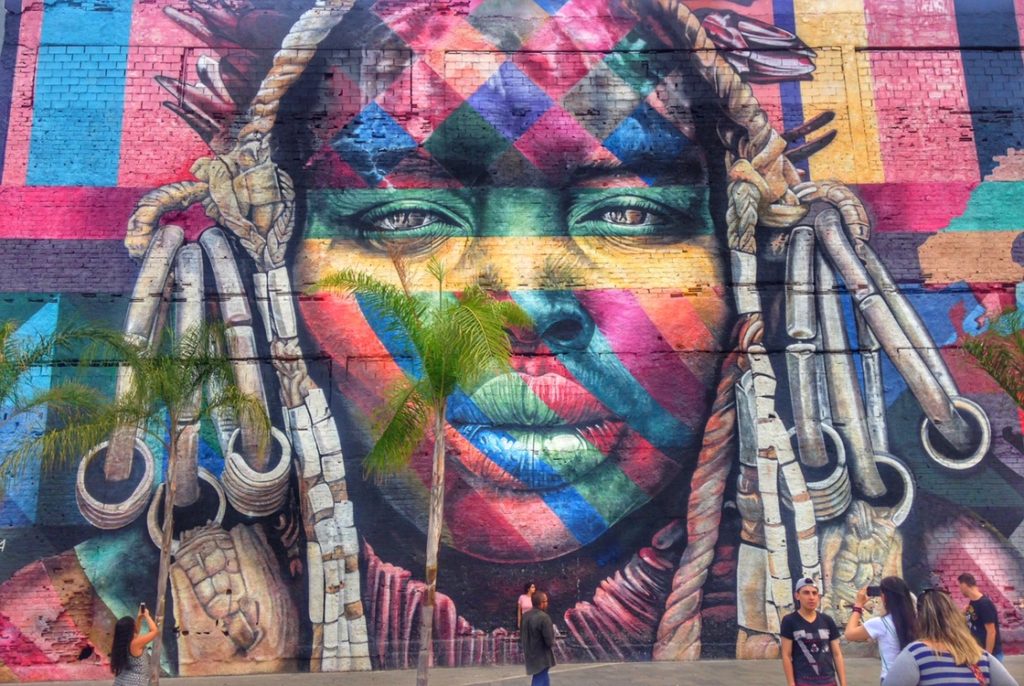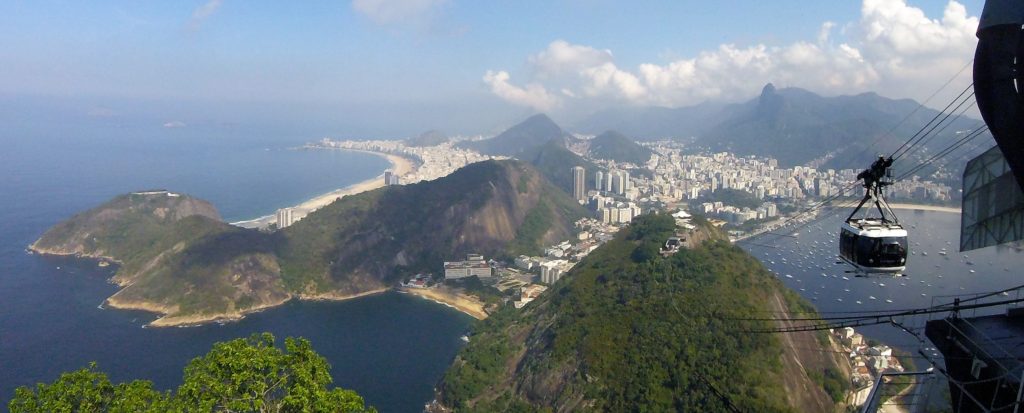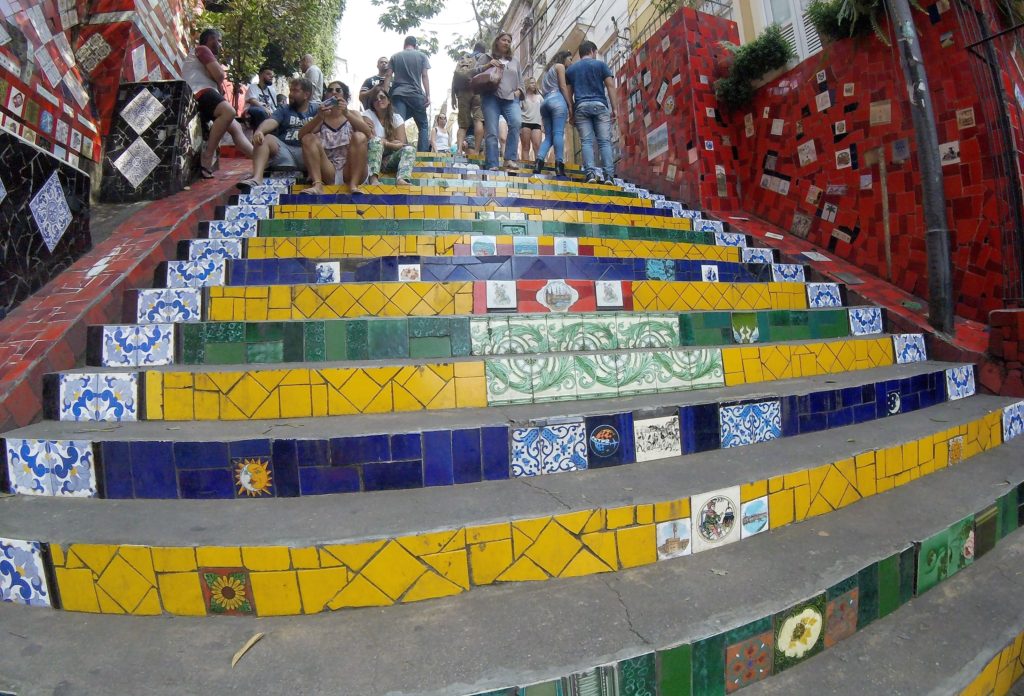Rio De Janeiro is such a beautiful city and the people are so friendly that it is easy to forget or deny its high crime rate. But the number of incidents and news reports keep us on our toes and vigilant of our surroundings. We left the favela where we spent five relaxing days and moved to Copacabana, one of the safer neighborhoods in the city.

We have tried to move around in most cities to catch a bit of the vibe from each sector. In Medellin, Colombia, we stayed in five different suburbs and we gained a true appreciation for Medellin and its amazing transformation.
As we got off the bus we saw two men going through a woman’s purse. She stood there staring off into the distance. Were they robbing her and she was resigned to the theft? It’s hard to tell. Many people suggest that if you are robbed just let it happen and move on. So one wonders, how many more muggings actually occur because many of them are probably never even reported.
Biking in Rio
Our new digs are in a high rise just three blocks from Copacabana beach, near everything we want to do during the rest of our stay here in Rio.
Rio de Janeiro is a bicycle-friendly city. There is a good network of bike paths that connect many of the sights. The city has implemented a bike-sharing program, and judging by the ubiquity of those orange bikes, it seems to be working well.

We rented bicycles to do a self-guided city tour. Every time I climb on a bike, start pedaling and feel the breeze I think, “This is freedom.” This day was no different.
We headed down to the waterfront and rode along the Copacabana beach. A large walking path and separate bike path follows the entire length of the beach. The smooth surface gave us a pleasant ride. The smell of the sea and salty air lures most of us into a calm and peace that says all is well with the world.
“There is something about a beach that makes people nicer”
“There is something about a beach that makes people nicer,” Rosario, our host, later told us. She said it is something that she has observed about cities and towns that have a beach. “It just calms everyone down,” she added.

In between Copacabana beach and Ipanema beach, there is a rock formation called Ponta de Arpoador. It provides a nice transition between both crescent-shaped beaches. Here we locked up the bikes and climbed around on the rocky area. This point provides a great view of Vidigal where we spent the prior week and Dois Irmaos that looms high above its surrounding peaks.
Thankfully these bikes have very comfortable seats, unlike the hard slivers we had during our ride through the Moon Valley. It was a beautiful ride in the driest desert in the world but we were sore for a few days after it. Here in Rio, we were quite comfortable all day long (and in the days that followed).
We rode along Ipanema beach and followed the path beside the canal that bisects the neighborhoods of Lebon and Ipanema and leads into Lagoa Freitas. We passed a few people fishing in the canal and they smiled and waved.
From the lake, we could see Dois Irmaos on one side and the Christ statue on the other side. The emblematic Christ the Redeemer statue stood high up with arms wide open as if watching over the entire city.
Sugarloaf Mountain
The city of Rio de Janeiro is peppered with large granite and quartz monoliths that rise dramatically from the ground. Sugarloaf is the most popular one. It offers 360 views of the city.
To reach the top of Sugarloaf (also known as Bondinho Pão de Açúcar) we hiked up the adjacent Morro da Urca. It is a smaller hill that has impressive views of its own although the more famous Sugarloaf overshadows it, and perhaps at certain times of the day, literally so. From the top of Morro Da Urca, we took the cable car to the top of Sugarloaf.

One of the major attractions near Medellin, Colombia is a town called Guatape. Guatape is known for its spectacular monolith named La Piedra that juts up 200m out of the ground. We climbed the 750 steps to the top of La Piedra which has the same appearance as Sugarloaf but is more similar to the height of Morro de Urca with 220 meters. However, instead of one embedded cement stairway like La Piedra has, the trail up Morro de Urca winds up through the jungle with stones and wooden steps to fortify the steep trail.
The Glass Gondola
The glass-sided gondola from Morro de Urca offers 360 views the entire way to the top of Sugarloaf 396 meters high. Well, it would be 360 views, but is normally full of people. So pick a side when you first get in and enjoy.
At the top, we loafed around (pun intended) on the few trails around it. There were also a few little picnic spots where we sat to enjoy the views. We could have taken a cable car from Vermelha beach (which has a statue of Fredrick Chopin, so random) to the top of Morro da Urca. I’m glad we hiked it. There is something to be said for a beautiful view after a good workout to get there. Especially after the easy access to Iguazu which we also enjoyed, but I like that the trail up Urca wasn’t too easy.

When Shots Fired are Common
I spoke with Rosario one afternoon. She told me about the time when she worked in a favela when she first came to Rio from Argentina, her home country.
“It was a nice place but they did have a shootout one day when I was there. People just walk around like it is normal. It is not normal,” she said shaking her head, “people shouldn’t get used to that”.
We continued to discuss the beautiful parts of the city.
“It’s a shame that it is so beautiful, but I can’t take my camera anywhere with me. It would get stolen,” she said.

We have far fewer pictures of Rio. I left my iPhone, my primary camera, locked in our room every day (see our travel safety tips). I walk around with virtually nothing except the GoPro around my neck hidden under my shirt. The GoPro enables me to get some pictures without the risk of personal data being stolen if someone takes it. I made sure that I had a memory card in the GoPro, unlike the astronaut who forgot the memory card during a spacewalk.
Trin has some money in a pocket I sewed inside his pants. He carries a little amount of money in his outer pocket. We call this our forced donation to a criminal element. It is enough money to make the assailant happy and not angry that he didn’t get anything.
Leaving Rio
So we left Rio without getting mugged or doing some of the other common tourist attractions like going up the Christ statue, but we enjoyed our stay.
Next, we took a flight north, then a bus, then a four-wheel drive adventure over sand dunes and through swamps. Finally a small hike over sand and through water in order to reach Lençóis Maranhenses National Park to find our opportunity for more adventure. More about that in a future post – if we find wifi to post it.


I’m so glad that you have left Rio. Just reading your posts made me shiver with fear. I would never be able to rest while there. But I know you are an adventurous person and so it is no big deal to you. Glad that you are able to enjoy all of these places that some of us just wish we could.
Thanks Jackie, we have been taking extra precautions. I’m not wearing any jewelry except a cheap $2 ring. I’m looking forward to wearing jewelry again in Argentina